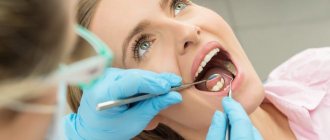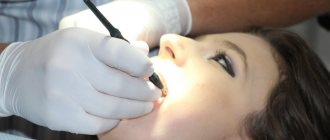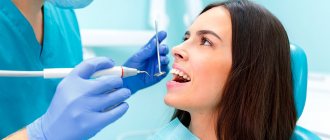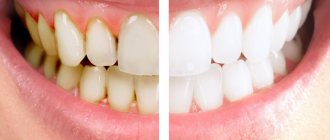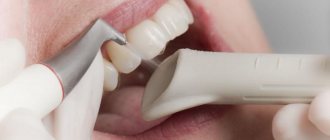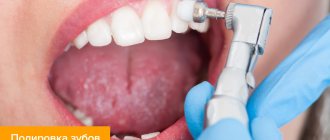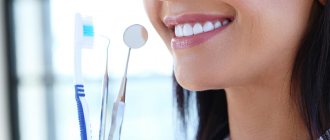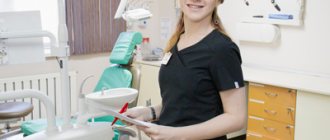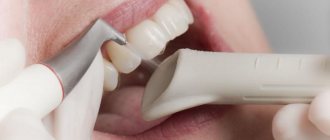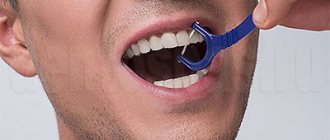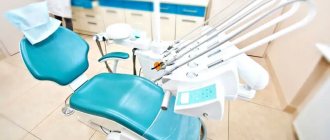Professional teeth cleaning is the removal of tartar and plaque in a dental office using special equipment.
Some consider this procedure useless and rely on high-quality oral care at home using modern toothbrushes. This is a misconception, and here's why.
Benefits of professional cleaning
Daily brushing of teeth has long become a ritual that is not always performed efficiently due to haste, sometimes due to basic laziness. Even with the most thorough cleaning with a good toothbrush, only 60% of plaque is removed, the remaining 40% is plaque on the back of the teeth, in the subgingival space and in the spaces between the teeth. Gradually, this plaque hardens, turning into tartar, which cannot be removed at home.
Dental plaque causes bad breath, caries, inflammation and bleeding gums. Long-term accumulation of microbes on dental plaque leads to the development of periodontitis - the roots of the teeth are exposed, the teeth become mobile, and begin to fall out. There is a risk of microbes penetrating from inflamed periodontal pockets into the blood, which provokes the emergence of secondary foci of infection in various organs: the heart, kidneys, joints, and thyroid gland.
Professional teeth cleaning is needed to:
- remove hard and soft dental deposits;
- prevent bleeding gums;
- eliminate bad breath;
- polish the enamel surface;
- prevent plaque adhesion;
- lighten the tooth surface;
- choose the right filling color for dental treatment;
- remove pigmented plaque after tea, coffee, “smoker’s plaque”;
- detect the initial stage of caries;
- avoid the occurrence of gingivitis and periodontitis;
- strengthen the enamel by treating it with fluoride gel.
Professional oral hygiene for a teenager
The main problem for teenagers is that they do not brush their teeth very well and regularly. At the same time, the diet usually contains little solid food for self-cleaning of teeth, but a lot of carbonated sweet drinks. As a result, plaque remains on the teeth for a long time, and the bacteria contained in the plaque produce acid, which softens the tooth enamel. If you detect white spots on the enamel in time, you can avoid drilling the tooth and try to restore the enamel using remineralizing agents.
For example, a 14-year-old patient brushed her teeth twice a week with a hard toothbrush. The plaque remained on the teeth for quite a long time. The indicator showed where plaque accumulated.
Air Flow cleaning, gum massage and enamel strengthening with Tuss Mousse cream with calcium and phosphorus were performed. Duration of the procedure is 1 hour. Cost – 4180 rubles. Hygienist Tatyana Kondratyeva.
Fortunately, the girl has naturally strong enamel and neutral acidity of saliva (Ph = 7.8), so after removing the plaque on the enamel, only white spots were found (caries in the staining stage), and not holes in the teeth.
The next visit to the hygienist is scheduled in 6 months.
The teenager is recommended to replace the toothbrush with a softer one, so as not to injure the gums and tooth enamel, and to use Remars gel at home to restore the enamel.
Causes of plaque and tartar
The formation of dental plaque occurs unnoticed. First, it is a thin film consisting of bacteria and their metabolic products. Poorly cleaned food remains serve as a breeding ground for microorganisms. Over time, the film becomes denser, an acidic environment is formed under it, and this contributes to the destruction of enamel and the occurrence of caries. Tea, coffee and tobacco cause the plaque to become dark in color.
Gradually, plaque mineralizes, that is, hardens, turning into plaque and then into tartar. Its color is yellowish, but you can find stones of brown, black, and red color. Coloring depends on the level of oral hygiene, nutrition, and bad habits.
The causes of tartar formation include:
- improper brushing technique;
- unsuitable toothpaste or brush;
- smoking;
- insufficient chewing of food;
- uneven teeth;
- chewing on one side;
- presence of braces, bridges, crowns;
- deviations in the functioning of the endocrine system.
Depending on the location, tartar can be subgingival or supragingival. When located subgingivally, the stone is brown or black in color; it cannot be detected independently; this can only be done by a specialist using a dental probe. Typically, stones of this type are found in older people.
Supragingival stones are easy to see without any devices: they are yellow or white deposits, most often found on the front teeth.
It is impossible to remove dense plaque and tartar on your own using normal hygiene procedures.
Cleaning methods
Currently, dentists offer several methods for cleaning teeth. The oldest is mechanical, when tartar is destroyed using a special tool in the form of hooks. This method can injure your gums, so it is rarely used.
One of the progressive methods is ultrasound. Cleansing is carried out using an ultrasonic scaler. Stones are destroyed by sound vibrations of a certain frequency, while plaque is removed and supragingival and subgingival pockets are cleaned. The doctor can use attachments of different sizes, depending on the complexity of the treatment area and the thickness of the plaque. In addition, during the work, water or an antiseptic is supplied to the oral cavity, which removes stone particles through a dental saliva ejector. The patient does not feel pain, but if the necks of the teeth are sensitive, the doctor administers local anesthesia.
Modern laser systems allow not only to remove the hardest tartar, but also to whiten teeth. The device causes the evaporation of moisture contained in plaque and removes deposits from the enamel in layers. At the same time, the enamel receives a lighter shade, and the achieved result of a snow-white smile will last for several years. The procedure is absolutely painless, but for certain categories of patients there are contraindications.
The latest Swiss technology Air Flow makes it possible to remove particles of plaque, stone and pigments in hard-to-reach places, clean subgingival pockets and polish enamel. Treatment is carried out with a jet of cleaning mixture, which consists of sodium bicarbonate and water. Under high pressure, this composition is applied to each tooth. Regular baking soda acts as an abrasive. This sandblasting method allows for high-quality hygienic treatment, removing all excess from the teeth, achieving a smooth surface of the tooth enamel and its natural lightening. The manipulation is painless and pleasant for the patient. The result is a Hollywood smile and clean teeth.
The VECTOR device is the latest word in dentistry. It is intended for the prevention and treatment of periodontitis and acts by vibration. This technique takes advantage of ultrasonic waves and the active action of a fluoride and calcium based cleaning mixture. Using such equipment, the doctor removes deposits and bacteria, cleans subgingival pockets and polishes tooth enamel.
Modern people have a wide choice of professional hygiene methods. A consultation with a dentist will help you choose the most suitable one.
Technique for professional teeth cleaning
The professional cleaning procedure lasts 1-1.5 hours and consists of the following steps:
- Preparation. The dentist determines the presence of tartar, caries, gum pathology and the degree of their development. If necessary, additional studies are carried out and tests are taken.
- Removal of dental stones. It is carried out using a dental device - an ultrasonic scaler. Ultrasound is capable of destroying tartar, while enamel is not affected by it. Stone removal occurs with the simultaneous supply of water pressure, which washes away destroyed particles and cools the teeth. The procedure is painless, but some patients feel discomfort during it, so local anesthesia using a gel or spray may be used. Tartar is also removed using laser systems. The method is based on the property of a laser to evaporate liquid. Tartar contains much more of it than enamel, so the laser destroys deposits layer by layer, evaporating moisture from them. During cleaning there is no contact between the instrument and tissues, which ensures a painless and sterile procedure. The laser has a bactericidal effect on pathogenic bacteria in the oral cavity and improves the absorption of medicinal substances by tooth enamel.
- Removing plaque, plaque and roughness after removing tartar. At this stage, the Air Flow air-abrasive system is used. Using water and baking soda, which are applied to the teeth under high pressure, all irregularities in the enamel are polished.
- Polishing the surface of the teeth. It is performed using an abrasive paste selected individually for each patient. The paste cares for fillings, makes the enamel surface perfectly smooth, which prevents the appearance of plaque.
- Application of fluoride-containing gel to the enamel. It envelops the teeth and protects them from increased sensitivity, strengthens tooth enamel. The gel lasts on the tooth surface from one to seven days.
The procedure for professional teeth cleaning should be done twice a year; the scope of work is determined by the doctor after an examination. By regularly visiting the dentist, you can avoid the formation of tartar, then cleaning will begin from the third stage.
The effectiveness of cleaning can be monitored using plaque indicators - special mouthwashes or chewable tablets that color plaque pink, blue or purple. The indicator is used before the cleaning procedure to assess the scale of upcoming work and identify plaque in hard-to-reach places; it is then applied to the teeth after brushing to see the results.
What it is?
Professional teeth cleaning means removing hard and soft plaque from teeth, as well as polishing them. Therefore, the procedure usually consists of two parts, and various methods can be used to remove the stone, for example:
- mechanical;
- ultrasonic;
- laser:
- sandblasting (Air Flow);
- using the VECTOR device.
In serious cases, the dentist may use a combination of several methods. Most often, ultrasonic cleaning is done, and then for final polishing, Air Flow is used.
In addition to caring for your teeth, professional cleaning takes care of the condition of your fillings and polishes the filling material. This allows you to preserve the original color of the filling and prevent its destruction.
During the manipulation process, the dentist performs a hardware removal of all excess from the tooth enamel and removes particles from the oral cavity. At the end, a protective fluoride varnish is applied, which reduces tooth sensitivity and contributes to the long-term preservation of the light tone of the enamel and the smoothness of each tooth.
Teeth cleaning for periodontitis
Periodontitis is also characterized by inflammation of the gums and the presence of dental plaque, which if left untreated can lead to tooth loss. Therefore, professional cleaning is a prerequisite for treating the disease. Removal of plaque and tartar is carried out using ultrasound and hand instruments; The procedure is often painful and therefore requires local anesthesia. After removing plaque, bleeding and swelling of the gums may increase, so it is important to use antiseptic solutions for rinsing to prevent infection of the gums.
Comments
But I’ll put implants in place of my teeth and won’t have to do any cleaning!
Artemy (06.06.2020 at 11:53) Reply to comment
- Dear Artemy, this will surprise you, but if you have implants and dentures, professional oral hygiene is also mandatory. In this case, the procedure must be carried out no less often than if you have natural teeth. Don't forget that the health of your implants largely depends on your oral health. If there is inflammation in the mouth caused by bacterial plaque (and it forms even when there are no teeth, on the gums and dentures), then the implants may be rejected.
Editorial staff of the portal UltraSmile.ru (06/14/2020 at 09:15) Reply to comment
At what age can a child have a brushing?
Natalya (06.28.2020 at 16:54) Reply to comment
- Dear Natalya, professional cleaning can begin when the child reaches the age of 3 years. True, for children the procedure is carried out slightly differently than for adults, using a special brush and paste. “Air-Flo” with a special finely abrasive and gentle powder can be used from 6 years of age, ultrasound – from 14 years.
Editorial staff of the portal UltraSmile.ru (07/01/2020 at 09:05) Reply to comment
Write your comment Cancel reply
Cleaning children's teeth
Professional cleaning is contraindicated for children, but their teeth also need care. Children do not know how to brush their teeth properly, so they often develop plaque on their enamel, which leads to caries or gum inflammation. Therefore, in childhood, you need to have your teeth cleaned by a dentist, who will clean each tooth separately using special brushes and pastes. After cleaning, the enamel is covered with a fluoride-containing gel, just like in adults.
Recommendations after professional teeth cleaning In addition to normal daily oral care, after professional teeth cleaning it is recommended:
- For 24 hours after the procedure, do not eat foods that have a coloring effect: beets, blueberries, cherries, mulberries, blue grapes, tomato sauces.
- Do not smoke, drink coffee or black tea for 24 hours.
- Brush your teeth or rinse your mouth with clean water after every meal.
- Use a soft-bristled toothbrush for several days.
- Choose a toothpaste that prevents the formation of deposits on tooth enamel.
The benefits and harms of the procedure
Having understood the theory of professional teeth cleaning (what it is, what types there are, how the dentist does this procedure), the patient is naturally interested in the advantages and disadvantages. There are many more advantages, these include:
- aesthetically attractive appearance of rows after hygienic manipulations;
- elimination of unpleasant odor from the oral cavity due to getting rid of colonies of pathogenic microorganisms;
- an integrated approach (not only removes accumulated plaque, but also prevents the development of serious dental diseases);
- absence of pain (except when discomfort is associated with pathological conditions and other factors listed in the previous subsection).
Unfortunately, there are also negative sides:
- gum sensitivity increases;
- the risk of injury to the enamel layer increases;
- infection is possible, so some patients are prescribed antibacterial drugs after visiting a hygienist.
Bleeding gums after professional cleaning
Sometimes you can come across complaints from patients that after cleaning their teeth from tartar, bleeding gums appeared. The reason is not the cleaning procedure itself, but the lack of qualifications of doctors. Therefore, you need to trust your health to professionals: find a good clinic where competent dentists will do everything right and avoid complications.
The financial costs of professional teeth cleaning are much less than the treatment of caries, which can be hidden under plaque, and its complications; Regular teeth cleaning by a specialist will help maintain your health, which means saving time and money.
Contraindications to the procedure
Like any medical procedure, teeth cleaning in a dental clinic has a number of limitations:
- increased sensitivity;
- the presence of erosion processes on the enamel;
- inflammation of the oral mucosa;
- history of arrhythmia;
- epilepsy;
- acute infectious diseases;
- diabetes;
- bronchial asthma, occurring in severe form;
- chronic rhinitis (including runny nose due to ARVI).
Ultrasound and Air Flow services are available to patients over 14 years of age.
Toothpicks and chewing gum
Dentists do not recommend using toothpicks at all. The wood from which they are made flakes when cleaned. The separated particles can remain between the teeth and, over time, begin to rot and cause inflammation. And also, while using a toothpick, you can injure your gums without even noticing it. Alternatively, use thread. It is a mistaken belief that chewing gum will help get rid of plaque and stuck pieces of food. Yes, undoubtedly, some parts of the remaining food will stick to the gum.
But during the chewing process, when the gums press against each other, these same particles can get stuck in the interdental space. In addition, recently placed fillings that have not withstood prolonged exposure “like” to stick to chewing gum.
Chewing gum does not strengthen the gums; this happens in the process of uniform chewing, and not when squeezing the jaws in one place. Chewing gum is usually one-sided and can lead to muscle atrophy on the opposite side because it will not receive the stress it needs.
Another disadvantage is that constant chewing will lead to overload of the periodontium. Against this background, periodontitis and gingivitis can develop.
Chewing gum contains dyes and sweeteners. Do not forget that dye E131 (contained, for example, in Stimorol chewing gum) causes the formation of cancer cells, E171 – liver and kidney diseases.
To remove food debris after eating, it is better to rinse your mouth with water 2-3 times or use a mouthwash or foam.
